Using AI to control energy for indoor agriculture
30 September 2024
Published online 26 August 2014
Juvenile whale sharks gravitate towards the central coast of the Saudi Arabian Red Sea near Al-Lith to a gathering point. Scientists hope this will help improve conservation efforts of the vulnerable fish.

© Greg Skomal
The whale shark, Rhincodon typus, is the largest fish in the world, growing up to 15 meters long. Scientists hope the discovery of this site will improve conservation efforts in the region after the International Union for Conservation of Nature classified whale sharks as "vulnerable" in 2000.
"In any conservation effort, it is important to protect juveniles long enough to ensure that they can reach a reproductive age or size," says researcher Michael Berumen from King Abdullah University of Science and Technology (KAUST). "Whale sharks are inherently difficult to study because of their potential long-range movements, unknown breeding patterns, and the amount of time that they spend below the surface. Protecting mating grounds would be a critical step in improving conservation for the species."
Several whale sharks were fitted with three types of satellite tags between 2009 and 2011 to record depth of dives, temperature profiles, and light level data. The individual sharks were tracked using Doppler-based geolocation.
The study shows that individual sharks habitually dived to 500 metres, with the maximum depth recorded at 1,360 metres. The temperature range was between 8 and 34°C.
However, it’s not yet clear why the sharks are attracted to this region, says co-researcher Simon Thorrold from Woods Hole Oceanographic Institution (WHOI). "The southern Red Sea is characterized by high levels of productivity which we suspect is the reason. So perhaps [its] some combination of warm water and lots of potential prey."
Other locations around the world are dominated by males. It is unclear why the Red Sea sharks are different.
The site’s relative safety could be another reason. "The Red Sea is home to few of the whale shark's natural predators," adds co-researcher Jesse Cochran from KAUST. "Only the orca whales are known to prey on whale sharks and they are considered rare in the Red Sea. Great whites, bull sharks and tiger sharks have all been suspected sources for bite scars on the whale shark. Of these, only the tiger shark is present in the Red Sea."
Researchers at KAUST hope to determine the reasons for the whale sharks’ attraction to the site. "We have initiated a multi-year study to try and fully understand the nutrient fluctuations, the oceanography, and the plankton dynamics in the Al-Lith area," says Berumen.
Most of the sharks continued to reside in the southern Red Sea during the tracking period, with around 10% of them leaving for the western Indian Ocean, probably due to abundant food linked to seasonal upwelling.
The researchers found that only juvenile whale sharks, ranging from 2.5 to 7 metres, congregate at the site, rather than small ones or adults. "This has led several researchers to suggest that the sharks use these sites to fuel their growth into maturity," says Cochran. "Once they hit maturity, the pressure to grow quickly is reduced, and their reliance on the ‘fast food’ diminishes."
An almost-equal ratio of males to females at the site also baffled the researchers. "[It] is a surprise because other locations around the world are dominated by males," says Thorrold. "However, at birth we believe that the sex ratio isn't biased, so obviously at other locations males and females are segregated by behavioural mechanisms. It is unclear why the Red Sea sharks are different."
So far, twelve whale shark congregation sites have been recognized worldwide. David Rowat, chairman of Marine Conservation Society, who was not involved in the study, says it is relevant as it defines a previously unknown site, similar to another area recently found in the Gulf off Qatar.
He hopes future research could include photo-identification for comparison. "Certainly a comparison of photo-IDs from this area to those from Djibouti and Qatar might provide a lot more useful information about the species' habits in this region."
doi:10.1038/nmiddleeast.2014.206
Stay connected: